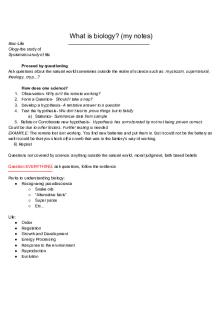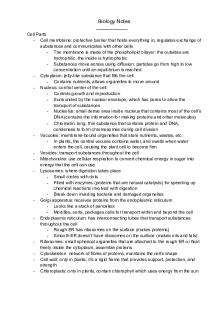Biology ia checklist - notes PDF

| Title | Biology ia checklist - notes |
|---|---|
| Author | Cat Tien Nguyen |
| Course | Cell Biology |
| Institution | Boston University |
| Pages | 4 |
| File Size | 139.7 KB |
| File Type | |
| Total Downloads | 64 |
| Total Views | 136 |
Summary
notes...
Description
IB Biology: Exploration IA (6) Background Information ___ Provide some context and significance for the investigation (why are you investigating this topic?) ___ Provide appropriate and relevant information to enhance understanding of the concept ___ Define key terms ___ Outline key scientific processes or concepts ___ Outline all the chemicals, why they were selected and also their uses/safety issues Research Question & Hypothesis ___ Write a clear and fully focused research question (it must include your dependent and independent variables) ___ Clearly state your hypothesis (prediction of what you will find) ___ Explain your hypothesis. Why do you think this will happen? ___ Support your hypothesis with research (including in-text MLA citations) Variables ___ State the independent variable (variable that was changed) – include units and ± uncertainties ___ State how you are going to change/manipulate your independent variable ___ If applicable, state the control for the experiment ___ State the dependent variable (variable that was measured) – include units and ± uncertainties ___ State how you are going to measure your dependent variable ___ List all of the controlled variables in a table (see example below) Controlled Variable
How will it be controlled?
Why it is important to control this variable?
Height of the lamp
The height of the lamp will be measured to 10.0 +/- 0.1 cm above the beaker using a 15cm ruler.
By keeping the height of the lamp controlled, the light intensity will remain constant for all trials during the photosynthesis experiment, and thus the results of the experiment will be due to the manipulation of the independent variable.
Volume of sodium bicarbonate solution
125.00 ml +/- 0.01 will be measured using a 150 ml graduated cylinder for each trial.
Sodium bicarbonate is the source of CO2 for the Elodea plant, so the amount of solution must be equal for all trials.
Size of the beaker
200 ml beakers will be used for all trials of this experiment.
The size of the beaker will ensure that the same length of the Elodea will be submerged under the solution.
Materials ___ List all of the materials needed for the experiment using bullet points ___ The quantity and size of all of the materials is listed (5, 150 ml beakers) Safety ___ Mention any safety, ethical or environmental considerations Procedure ___ Write a detailed procedure in numbered steps in the same order that they should be performed ___ Every step is included even though they may be obvious (i.e. zeroing the balance) ___ Each material has been accounted for in detail (size of beaker, volume of solution, units of electronics) ___ State how many trials will be performed at each range/interval of data (5x5 minimum) ___ Could someone read this procedure and easily repeat it ___ The data gathered enables the aim, the research question or the hypotheses to be adequately addressed. ___ State how you will use the data (what statistical tests will you use? And why.)
IB Biology: Analysis IA (6) Raw Data Tables ___ A table with all of the quantitative raw data (data you collected) and class data (if applicable) ___ The table has a detailed title and headers for each column and/or row
___ All data has uncertainties (i.e. 22°C ± 1) ___ The uncertainties are all justified. ___ All units are included in the header (do NOT write the unit in each cell of your table) ___ All data has the same precision (you should NOT have one measurement as 22°C and another 23.78°C) ___ Highlight the data that you collected (only for group/class data) ___ A table with the qualitative data you found (color, change in size etc.) ___ Include images (figure #) of the equipment set-up and the experiment itself Processed Data Table (Could be combined with raw data in one table) ___ State and explain any anomalies (data that did not fit with the trend you see) ___ Describe how you are processing the data and why you chose to do that ___ Process the data correctly and completely (an average is insufficient) ___ Include one complete sample calculation for each different calculation that was not completed by excel ___ Perform additional statistical analysis (ttest, correlation, Chi-square) ___ Processed data has the same precision as the raw data ___ State all of the technology that was used (Excel, calculators etc.) ___ Describe the trend or pattern you see in the data ( Analysis) ___ State in words what you found but do NOT explain it Presenting/Graphing Data ___ Plot the processed data in a suitable graph (DO NOT GRAPH RAW DATA) ___ Ensure independent variable is on the x-axis and dependent variable is on the y-axis ___ Title your graph and both axes (including the units and uncertainty) ___ Add error bars to the graph (if applicable) ___ Describe to reason for including error bars and wat they mean ___ Add a trend-line to the graph (if applicable) ___ Add a figure number and title underneath/above your graph (Fig 1. A scatter plot showing…) ___ Describe the trend or pattern you see in the data ( Analysis) ___ State in words what you found but do NOT explain it
IB Biology: Evaluation IA (6) Conclusion ___ Restate your research question and hypothesis (The purpose of this lab was to…) ___ State an appropriate and reasonable conclusion based on your results that answers your research question ___ Summarize your findings using actual numbers and referring to tables and graphs ___ Explain and justify your results using correct biological terms ___ Include other sources (internet, books etc) that also support what you found ___ Compare your results to accepted scientific concepts ___ If your results don’t support the generally accepted truth, explain this limitation and suggest reasons why your results differ from the norm
___ Include MLA in-text citations here ___ Accept or reject and modify your hypothesis ___ Do NOT use the word “prove” Evaluation Problem (Sources of Error/Limitations) ___ Mention the main weaknesses in the procedural design of the experiment (did you control for all your controlled variables? Were all the materials working correctly?) ___ Consider sources of human error, random error, instrumental error, measurement error, replicate size, trial number, etc.( as applicable) ___ Evaluate limitations of your data (quantity, quality, accuracy, precision) ___ All significant sources of error/limitations have been recorded Explanation of Problem (How did the source of error/limitations affect your results?) ___ State how those weaknesses affected your results ___ State whether or not the weaknesses and limitations were serious enough to undermine the conclusion Improvement (How to modify/improve/extend this experiment?) ___ Suggest how each source of error can be specifically modified to improve the accuracy of the results Explanation of the improvement ___ Explain how the improvements will be achieved. They must be realistic and relevant. Problem 1: Explanation of problem: Improvement: Explanation of the improvement: Problem 2: Explanation of problem: Improvement: Explanation of the improvement: Strengths and Extensions (paragraph under table) ___ State and explain the strengths of this experiment ___ Suggest at least one possible extension for this experiment
IB Biology: Communication (4) Presentation Structure and Format ___ Research question as the title ___ Name on the top right corner ___ Submitted in Times New Roman 12pt font ___ Single spaced ___ Page numbers on the bottom right corner ___ Correct headers are bolded (the same headers as the IA checklist) ___ Spell checked ___ Checked for proper grammar ___ Scientific writing is clear and concise ___ Correct use of scientific vocabulary ___ MAXIMUM of 12 pages (otherwise you will lose marks)
(MLA) Works Cited ___ Sources are listed in alphabetical order
___ Indentation occurs on second and third line of each source ___ Entire works cited is double space
IB Biology: Personal Engagement (2) Personal Engagement ___ Justify your choice of research question - why did you choose this topic? ___ Explain how research question/topic has personal significance or interest to you ___ Explain how you took initiative during the design, implementation and presentation of this investigation...
Similar Free PDFs

Biology ia checklist - notes
- 4 Pages

Ia-checklist
- 1 Pages

2019 IB Psychology IA Checklist
- 1 Pages

Biology IA Proposal
- 2 Pages

IB HL Biology IA
- 12 Pages

Biology SL Syllabus & Checklist
- 15 Pages

Biology Notes
- 7 Pages

Biology Notes
- 16 Pages

IA- Reviewer - Lecture notes 1
- 74 Pages

IA-2 - Lecture notes 1
- 3 Pages

Checklist
- 6 Pages

Checklist
- 8 Pages

Kmeans ia
- 16 Pages
Popular Institutions
- Tinajero National High School - Annex
- Politeknik Caltex Riau
- Yokohama City University
- SGT University
- University of Al-Qadisiyah
- Divine Word College of Vigan
- Techniek College Rotterdam
- Universidade de Santiago
- Universiti Teknologi MARA Cawangan Johor Kampus Pasir Gudang
- Poltekkes Kemenkes Yogyakarta
- Baguio City National High School
- Colegio san marcos
- preparatoria uno
- Centro de Bachillerato Tecnológico Industrial y de Servicios No. 107
- Dalian Maritime University
- Quang Trung Secondary School
- Colegio Tecnológico en Informática
- Corporación Regional de Educación Superior
- Grupo CEDVA
- Dar Al Uloom University
- Centro de Estudios Preuniversitarios de la Universidad Nacional de Ingeniería
- 上智大学
- Aakash International School, Nuna Majara
- San Felipe Neri Catholic School
- Kang Chiao International School - New Taipei City
- Misamis Occidental National High School
- Institución Educativa Escuela Normal Juan Ladrilleros
- Kolehiyo ng Pantukan
- Batanes State College
- Instituto Continental
- Sekolah Menengah Kejuruan Kesehatan Kaltara (Tarakan)
- Colegio de La Inmaculada Concepcion - Cebu


